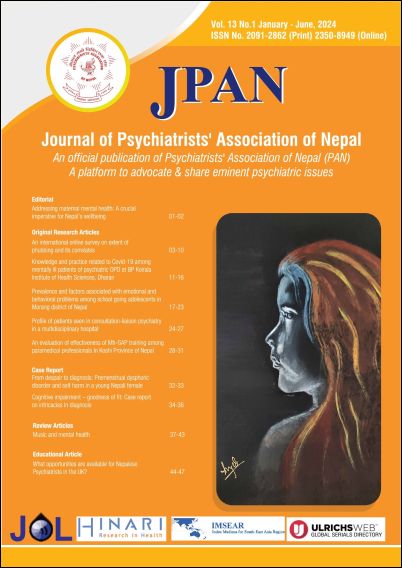An international online survey on extent of phubbing and its correlates
DOI:
https://doi.org/10.3126/jpan.v13i1.68179Keywords:
phubbing, mobile use, couples' satisfaction, anxiety, depressionAbstract
Introduction: Phubbing can be described as an individual looking at his or her mobile phone during a conversation with other individuals, dealing with the mobile phone and escaping from interpersonal communication. Being a new concept, research on its correlates is limited. The aims of the study were to find the extent of phubbing and its correlates.
Material & Methods: It was an online survey through Google forms with cross-sectional design and convenience sampling. Those above 18 years who were willing to participate and provided consent were included. The questionnaire included socio-demographic and clinical details, Patient health questionnaire (PHQ-4), and couples ‘satisfaction index (CSI) scale. Descriptive statistics, group comparisons, and Pearson's correlation were done.
Results: 904 participants (463 from India, 224 from Nepal, 132 from Indonesia, others 85) were included in the study. 2.3% had a higher likelihood of phubbing. The total phubbing score showed a statistically positive significant correlation with the duration of internet use (p<0.001), social media use (p<0.001), and total PHQ score (p<0.001) and statistically negative significant correlation with duration of the relationship (p=0.004), and total CSI score (p<0.001). Phubbing was significantly higher among males (p=0.044), those educated less than graduate level (p=0.012), in a relationship (p=0.009), using psychoactive substances frequently (p=0.001), dissatisfied with the relationship (p=0.024), and among those with anxiety (p<0.001) and depressive symptoms (p<0.001). There was no difference in phubbing in between the countries (p value= 0.193).
Conclusion: Prevention and management of phubbing should target those at risk. Focusing on reducing phubbing will improve mental health, couples’ relationship, and reduce excessive internet and social media use.
Downloads
Downloads
Published
How to Cite
Issue
Section
License
Copyright (c) 2024 Journal of Psychiatrists' Association of Nepal

This work is licensed under a Creative Commons Attribution 4.0 International License.
This license enables reusers to distribute, remix, adapt, and build upon the material in any medium or format, so long as attribution is given to the creator. The license allows for commercial use.




